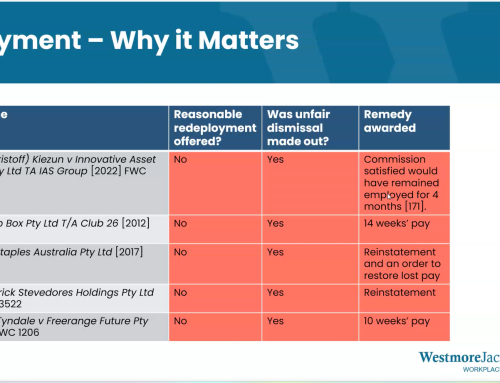
Employers can take several practical steps to reduce the risk of ex-employees from poaching clients. Below are our top tips.
Use Well-Drafted Restraints
It probably goes without saying. However, a well-drafted post-employment restraint is one of the best steps employers can take to reduce the risk of ex-employees poaching clients.
If your company’s post-employment restraints were drafted some years ago, or seem very wide in their application, then there is a good reason why they should be reviewed. The law regarding post-employment restraints keeps evolving. A post-employment restraint that was adequate 10 years ago may now be unenforceable.
It is also important to remember the Courts take a very different approach to restraints in commercial contracts than those in employment contracts. Inserting into an employment contract a restraint intended for a commercial contract is generally fraught with danger.
If in doubt, get your post-employment restraints checked by an employment lawyer.
IT
Employers should consider whether their IT systems adequately record and retain information that might be helpful for dealing with ex-employees who intend to poach clients.
IT systems that record and retain information regarding deleted emails, workplace entry and exit times, and the transfer of information to external devices can be very useful.
Let’s say an employee has done something dubious during their notice period such as downloading client contact details onto an external device. Records of this can be helpful in asking (and hopefully gaining) an employee’s commitment to, amongst other things, not poach clients. Further, these records can become important evidence if legal proceedings against the ex-employee are necessary.
No Personal Phones and Devices for Work
When an employee uses a personal device for work, such as a laptop or phone, it provides them with easier access to important information such as client contact details. If the employee resigns he or she may, either inadvertently or otherwise, have ready access to confidential information after ceasing employment.
Ensuring employees only use company computers and other electronic devices has other advantages. Let’s say an employee during their notice period downloads client contact details onto an external device. Evidence of this conduct can be more difficult to obtain if the employee (instead of the employer) owns the device.
If an employer owns a device used by an employee, then the employer is in a better position to obtain the device when the employee resigns. Once the device is in the employer’s hands, it can be imaged and searched for important information (for example, emails sent to an employee’s personal email address). Again, this information can be very helpful in asking (and hopefully gaining) an employee’s commitment to, amongst other things, not poach clients. This information may also be very important if legal proceedings are necessary.
Develop a Key Employee Departure Process
Some employees are critical to a company’s success. An example may be a sales executive who has strong relationships with your top clients.
For these employees, employers may wish to consider adopting contingency plans to deal with a key employee’s departure.
A key employee departure process may include several protocols. These include:
- Immediate return of company property, including computers and other electronic devices;
- Limiting an employee’s access to key documents;
- Depending on the circumstances and the employee’s employment contract – requiring the employee to go on gardening leave;
- Potentially imaging or checking of an employee’s computer, phone or other devices.
Get Advice Early
Like many areas of the law, getting early advice can be important to not only the outcome, but also the overall cost of dealing with the issue.
Adam Colquhoun, Principal
WestmoreJacobs®
This article is general information only. If you need legal advice, then please contact us.
Liability limited by a scheme approved under Professional Standards Legislation






Leave A Comment